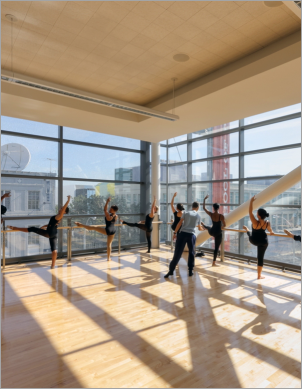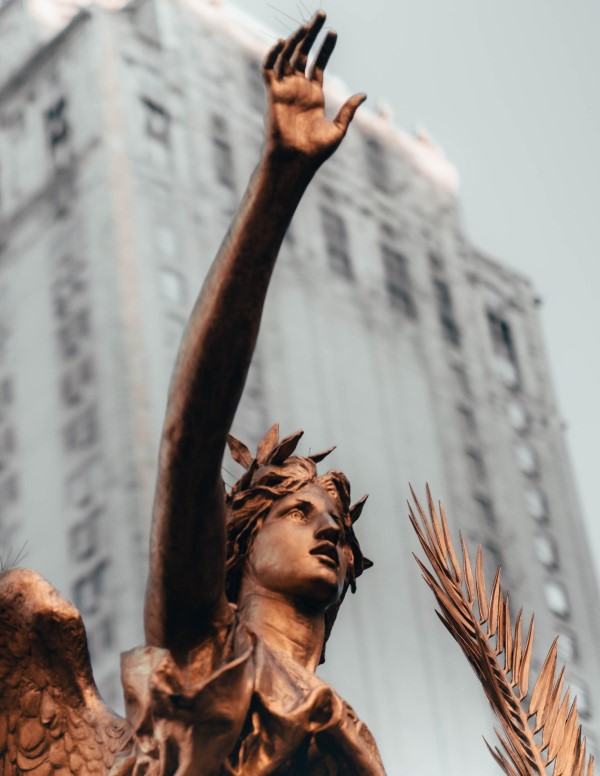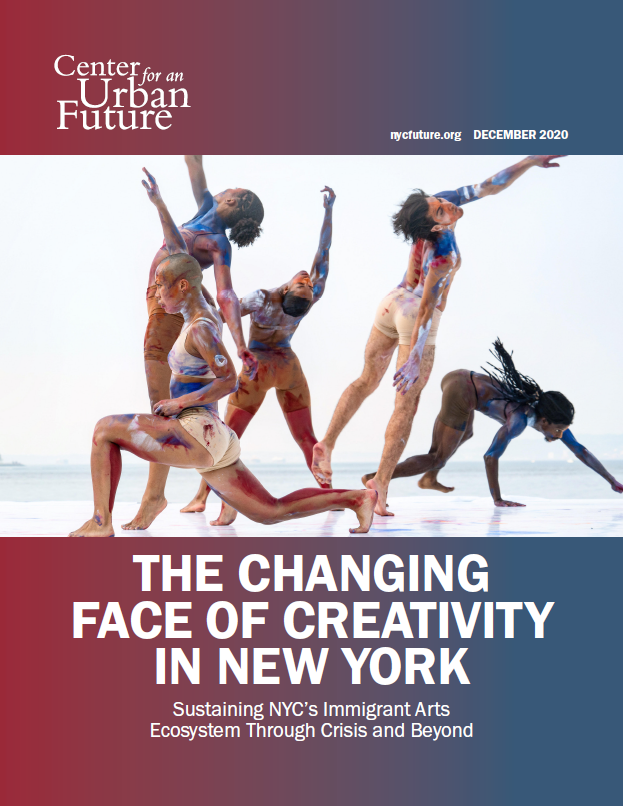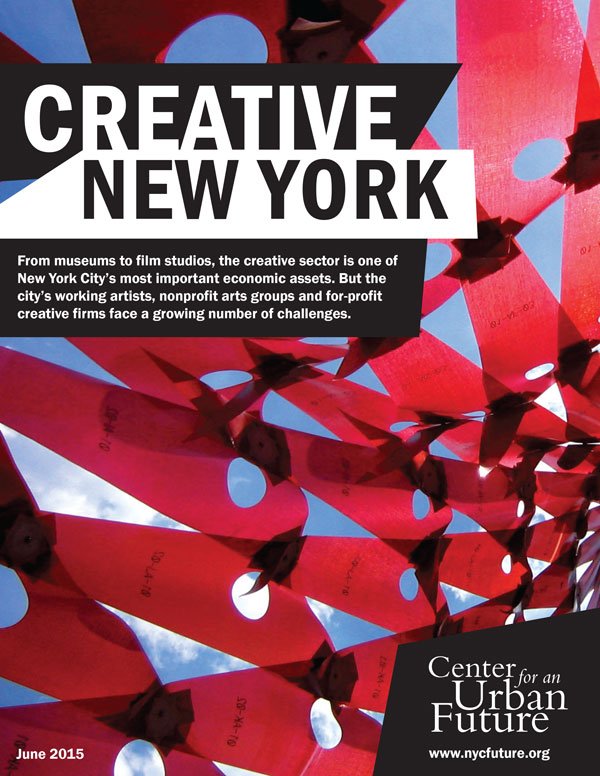Despite Patti Smith’s frequent admonition to young, aspiring artists to “find a new city,” New York remains a magnet for the creative and inspired. In the face of rising rents and other costs throughout the city, a new analysis by the Center for an Urban Future (CUF) shows that the number of artists nonetheless grew in nearly every discipline, borough, and neighborhood between 2000 and 2015. As New York City prepares to unveil its first citywide Cultural Plan, it is important to understand how the shifting geography of the city's artist population affects issues of affordability, community-building, and access to resources.
Artist communities have flourished throughout much of the city over the past decade and a half. Citywide, the ranks of artists swelled to 56,268 in 2015, an all-time high, marking a 17.4 percent increase since 2000.
Yet Smith is not entirely wrong, either. Although the city has never been home to more artists than it is today, it is now harder than ever for artists to make work in New York. The city’s surging population and economy have made it increasingly difficult not only to find and afford an apartment but also the studio and practice space that have incubated New York's emerging artists for generations.
According to the Center for an Urban Future’s latest analysis, there are not only more artists in New York, there are more artists all over New York, many of whom are struggling to get by. CUF's analysis shows that the artist population increased in nearly three-quarters of the city's Census-defined neighborhoods since 2000, including massive jumps in Brooklyn and the Bronx, as artists seek more affordable space further from Manhattan. The analysis finds that most of the growth in the artist population is occurring in Brooklyn, Queens, and the Bronx—although Manhattan continues to house more artists than the other four boroughs combined.
Since 2000, the Bronx saw the number of visual and performing artists nearly double, to 2,920 from 1,524, while Manhattan experienced a 10 percent decline, to 25,650 from 28,454. Brooklyn and Queens both saw strong growth (up 72 percent, to 17,605 in Brooklyn, and up 35 percent, to 8,726, in Queens), while Staten Island grew 8 percent, to a total of 1,367 in 2015.
Arts Communities Are Growing in Neighborhoods Citywide
These trends may seem familiar, yet they also underscore how the artistic exodus in Manhattan is not nearly on the scale many might assume. Meanwhile, for all the focus on Brooklyn or the South Bronx, the number of artists there still lags far behind Manhattan. Even at the current pace, Manhattan's top spot will not be challenged for many years to come.
The most dramatic transformations are underway at the neighborhood level. Unsurprisingly, yet no less incredibly, the number of artists in Bushwick rose more than 1,100 percent—by far the greatest increase—to 1,824 in 2015 from 150 in 2000. Yet it still ranked number 11 on the list of neighborhoods with the largest number of artists.
The top spot belongs to the Upper West Side, and has for some time, although the number of artists there increased just 2.5 percent over the period, to 5,584. By comparison, the number two spot—held by Greenwich Village, TriBeCa, and the Financial District—lost 24 percent of its artists, dropping to 3,989, while Chelsea and Hell's Kitchen fell more than 28 percent, to 3,711 artists.
The only other major areas to see such sharp declines were the Lower East Side and Chinatown, which fell 17 percent, to 2,413 artists; and Turtle Bay, Murray Hill, and Stuyvesant Town, which lost 37 percent of their artists, for a total of 1,730 in 2015.
One of the biggest gainers, and now the fifth-most artist-saturated area in the city, is Williamsburg and Greenpoint, which has 2,908 artists, an increase of 75 percent. However, the neighborhood may have reached "peak artist": its artist population hit an all-time high of 2,986 in 2014 and then dropped by 78 residents over the following year. Williamsburg and Greenpoint are now home to just 141 fewer artists than the Upper East Side, which reclaimed the number four spot in 2015 but has lost nearly 2 percent of its artists since 2000.
Park Slope and Caroll Gardens saw a 20 percent gain, to 2,602 artists, enough to claim the sixth spot. Fort Greene, Brooklyn Heights, and Downtown Brooklyn grew 58 percent to 2,445 artists, narrowly coming in seventh after experiencing a decline since 2014. The areas that saw the most growth, after Bushwick, were Bedford Stuyvesant, with 1,061 artists, a 268 percent increase; North Crown Heights and Prospect Heights, which rose 114 percent to 1,278; and Sunset Park, which rose 124 percent to 993 artists.
Manhattan did see some significant upswings, most notably Central Harlem, where the number of artists shot up 216 percent to 956.
The South Bronx also saw the emergence of an expected in-migration, with Mott Haven jumping 43 percent to 288, much of it over the past two years. However, the borough’s biggest boost, and the area with the most artists, is around Co-op City and Throgs Neck, where 637 artists now reside, up 286 percent from 15 years earlier. The area stretching from Morrisania to East Tremont, to the east and north of Yankee Stadium, also saw a sizable increase, 113 percent to 285 artists, while the Riverdale and Kingsbridge area grew 72 percent to 365 artists.
In Queens, the greatest concentration of artists is in Astoria / Long Island City, with 1,919, 40 percent more than in 2000. Sunnyside and Woodside come in second with 934 artists, also increasing 40 percent. The neighborhood with the most artistic growth was Jackson Heights, which rose 176 percent, to 618 artists.
Ten Neighborhoods with the Most Artists, 2015
1. Upper West Side (5,584)
2. Greenwich Village / Financial District (3,989)
3. Chelsea / Clinton / Midtown (3,711)
4. Upper East Side (3,049)
5. Williamsburg / Greenpoint (2,908)
6. Park Slope / Carroll Gardens (2,602)
7. Brooklyn Heights / Fort Greene (2,445)
8. Lower East Side / Chinatown (2,413)
9. Washington Heights / Inwood (1,995)
10. Astoria / Long Island City (1,919)
Ten Neighborhoods with the Largest Increase in Artists, 2000 to 2015
1. Bushwick (+1,674 / 1116%)
2. Williamsburg / Greenpoint (+1,248 / 75%)
3. Brooklyn Heights / Fort Greene (+899 / 58%)
4. Bedford Stuyvesant (+773 / 268%)
5. North Crown Heights / Prospect Heights (+680 / 114%)
6. Central Harlem (+653 / 216%)
7. Astoria / Long Island City (+552 / 40%)
8. Sunset Park (+550 / 124%)
9. Throgs Neck / Co-op City (+472 / 286%)
10. Park Slope / Carroll Gardens (+433 / 20%)
Artists and Schools Could Share Resources
As artists have spread out across the city, they often find themselves living further from the work spaces, exhibition spaces, and collaborators on which their work relies. At the same time, skyrocketing housing costs, which have led to the artistic diaspora, have also put a squeeze on studios, venues, and performance spaces.
Our 2015 Creative New York report found that in the ten community districts most closely associated with art and creativity, rents rose by at least 32 percent from 2000 to 2012, outpacing rent increases across the city as a whole. Over the same span, information, media, and tech companies experienced significant growth as well. In 2002, these industries occupied 9 percent of New York’s office space; by 2012, they had rented 25 percent, with many filling the kind of industrial loft buildings artists have long favored.
Yet these challenges can also serve as a valuable opportunity not only for artists to work closer to home but also to bolster the arts in their communities, helping to sustain art-making citywide.
The growth of the city's arts communities and these shifting geographic patterns should inspire the city to think creatively about ways to address the unique needs of artists and arts organizations. One promising place to start is inside the city’s public schools, many of which contain a plethora of underutilized arts spaces. There are 1,456 visual arts rooms, 1,439 music rooms, 1,412 theater spaces, 1,425 dance studios, and 1,415 film production and editing facilities in the Department of Education’s 1,800-plus schools. After school hours, most are unoccupied—except for storage. Opening up these spaces to local artists could help address the massive need for studio space while strengthening arts education and exposure in neighborhoods and schools that could benefit enormously from a more deeply embedded arts community.
While New York City’s performing and visual artists have scattered throughout the five boroughs, nonprofit studio and performance spaces remain largely clustered in Manhattan. School arts facilities, on the other hand, are as dispersed as New York's artist population.
Brooklyn has far more visual arts rooms than Manhattan, for example, 446 to 278, as does the Bronx, with 339. Queens comes close with 322, and Staten Island has 71. Music rooms are similarly concentrated (435 in Brooklyn, 339 in the Bronx, 321 in Queens, 274 in Manhattan, and 71 in Staten Island), as are theater spaces (426 in Brooklyn, 322 in the Bronx, 315 in Queens, 269 in Manhattan, and 70 in Staten Island). While students of course sometimes use these facilities for after-school activities, the opportunities for artists to activate these spaces after hours are compelling, especially when they might otherwise be sitting empty.
School art spaces pose a particularly important opportunity in part because many of the neighborhoods with large artist populations also have a high density of school facilities.
School Arts Facilities Are Clustered in Many Growing Arts Districts
In Brooklyn, the district covering Greenpoint and Williamsburg has 34 visual arts rooms, 33 music rooms and 31 theater rooms, while the Crown Heights and Prospect Heights district has 47, 47, and 44, respectively. The Queens district covering Astoria, Long Island City, and Jackson Heights has both 47 art and music rooms, while the Bronx district for Throgs Neck has 50 art rooms and 48 music rooms. The Upper West Side is equally full of such facilities, with 41 arts rooms, 41 music rooms, and 40 theater rooms.
Making room for working artists and groups in these spaces will not be easy, of course, or free. Liability issues and bureaucratic hurdles will be daunting. Security, custodial, insurance, and utility expenses will be considerable. Still, artists are an industrious sort, and the city should be, too, to ensure New York remains attractive to working artists and fully harnesses the opportunity to distribute the benefits of artistic production citywide.
To help cover the cost of making space for artists in schools, the de Blasio administration could work with local foundations, borough presidents, and Spaceworks, a nonprofit that develops affordable studio space. The Department of Cultural Affairs might take the lead, recruiting funders and partnering with the Department of Education to convene principals, custodians, and other parties who can help overcome bureaucratic issues. The Department of Youth and Community Development, which runs Beacon school-based community centers, should also be involved. Its experience repurposing school spaces in off hours and the enormous potential of school-based artists to enhance existing youth programming.
Collaborations such as these may not end with artists, given the growing spatial and cost constraints of a swelling city. Nor is this the only answer to artists’ continued struggles to make it in New York (for many more, see the Center's Creative New York report).
If the city wants to continue to be a haven for cultural producers of all kinds, then officials should be just as creative in finding solutions as the painters and dancers and photographers who still want to live and work here. A partnership with city schools could be one important component of a citywide strategy to tackle this affordability crisis.
Please also check out some of our other recent publications about the importance of the arts in New York:
The Unkindest Cuts: NYC Has the Most to Lose if the NEA is Abolished
Creative New York
A Small Boost in Arts Funding Would Go A Long Way
Open Up Schools to Priced-Out Artists
Help Artists Revive NYC Neighborhoods: Build Up Culture and Housing at the Same Time
City Officials Must Do More to Boost NYC’s Creative Sector
Data source: CUF analysis of U.S. Census, 2015 American Community Survey data. Tabulated using IPUMS USA.
Photo credit: Frank Sinatra School of the Arts / Ennead Architects





